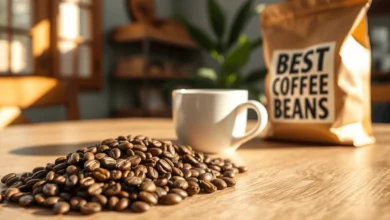Ultimate Guide to Different Types of Coffee
As a coffee lover, I’ve always been amazed by its rich variety. Every sip takes me to a world of complex tastes and smells. Coffee brings people together, starts conversations, and energizes our days. In this guide, we’ll dive into the world of coffee, exploring its many Types of Coffee, brewing ways, and special experiences.

Table of Contents
Types of Coffee
Key Takeaways
- Discover the differences between Arabica and Robusta coffee beans and their impact on flavor and caffeine content.
- Explore the wide range of coffee drinks, from classic black coffee to espresso-based beverages and milk-based specialties.
- Learn about the impact of coffee roasting levels on the taste and aroma of your coffee.
- Understand the various brewing methods and equipment used to craft the perfect cup of coffee.
- Dive into the world of specialty coffee drinks and regional variations that offer unique flavor experiences.
Introduction to Coffee: Understanding the Basics
Coffee is a favorite drink with a long history and a big place in culture worldwide. It comes from the seeds of Coffea plants, with over 100 types found globally. The main types grown for sale are Coffea arabica (Arabica) and Coffea canephora (Robusta).
Coffee is good for you because of its antioxidants and caffeine. It can make you smarter, happier, and might even lower the risk of some diseases. Making coffee involves growing, picking, processing, roasting, grinding, and brewing. Each step affects the taste.
Arabica beans, which make up 60-70% of coffee, have softer, more complex tastes. Robusta beans, on the other hand, have more caffeine and a harsher taste. There are also less common beans like Liberica and Excelsa, which taste fruity, floral, and tart. These add to the variety in coffee culture.
Types of Coffee
| Types of Coffee | Flavor Profile | Caffeine Content |
|---|---|---|
| Arabica | Soft, nuanced | Lower |
| Robusta | Strong, harsh | Higher |
| Liberica | Fruity, floral, tart | Moderate |
| Excelsa | Unique, complex | Moderate |
Knowing the coffee basics and the many coffee beans origins is key to enjoying all the flavors and experiences coffee offers.
Types of Coffee Beans
The world of coffee is vast and diverse. It has many bean varieties, each with unique flavors and characteristics. Arabica and Robusta beans are the most common, making up most of the world’s coffee. But, there are also many lesser-known varieties to explore.
Arabica Coffee Beans
Arabica beans are prized for their smooth, complex flavors and higher acidity. They grow best in cool, high-altitude places. Arabica beans have less caffeine than Robusta beans.
Robusta Coffee Beans
Robusta beans are the second most popular, making up about 40% of global coffee. They have a more bitter taste and more caffeine. Robusta beans are used in instant coffee and espresso blends because they can handle high temperatures.
Lesser-Known Coffee Bean Varieties
- Liberica: A rare coffee bean variety from West Africa. It has a distinct floral and smoky flavor. Liberica beans are rare, making up only about 2% of the world’s coffee supply and are mainly grown in Malaysia.
- Excelsa: Excelsa beans are grown almost entirely in Southeast Asia. They are known for their complex, fruity, and slightly tangy notes. This variety is a small part of the global coffee market.
The choice of coffee bean greatly affects the taste, aroma, and caffeine content of the brew. Knowing about different bean varieties helps coffee lovers find their favorite flavors.
| Coffee Bean Variety | Market Share | Key Characteristics | Primary Growing Regions |
|---|---|---|---|
| Arabica | 60-70% | Smooth, complex flavors, higher acidity, lower caffeine | Brazil, Colombia, Ethiopia, Central America |
| Robusta | 30-40% | Bitter taste, higher caffeine content | Vietnam, Indonesia, Africa |
| Liberica | ~2% | Floral, smoky flavor profile | Malaysia, West Africa |
| Excelsa | Minimal | Complex, fruity, and slightly tangy notes | Southeast Asia |
Types of Coffee
“The choice Types of Coffee bean can significantly impact the taste, aroma, and caffeine content of the final brew.”
Coffee Roasting Levels and Their Impact on Flavor
Coffee roasting turns green coffee beans into brown ones with a great smell. It changes the taste, smell, and caffeine in coffee. Knowing about different roasting levels helps you pick the coffee you like best.
There are four main roasting levels: light roast, medium roast, medium-dark roast, and dark roast. Each level has its own taste and qualities:
- Light Roast: Light roast beans are roasted at 356°F – 401°F. They keep more of the bean’s taste and have the most caffeine.
- Medium Roast: Medium roasts are at 410°F-428°F. They have a balanced taste and smell, liked by many.
- Medium-Dark Roast: Medium-dark roasts are at 437°F – 446°F. They taste richer and have more body than light roasts.
- Dark Roast: Dark roasts are at 464°F – 482°F. They have a strong taste and less caffeine because they’re roasted longer.
Choosing a roast level depends on what you like and how you brew your coffee. Light roasts are great for their complex tastes. Medium roasts are balanced. Dark roasts are for those who want a bold coffee.
| Roast Level | Temperature Range | Flavor Profile | Caffeine Content |
|---|---|---|---|
| Light Roast | 356°F – 401°F | Bright, acidic, and nuanced | Highest |
| Medium Roast | 410°F-428°F | Balanced, caramelized sweetness | Moderate |
| Medium-Dark Roast | 437°F – 446°F | Richer, fuller flavor, less acidity | Moderate |
| Dark Roast | 464°F – 482°F | Bold, rich, less acidic | Lowest |
The roasting process is key to making coffee beans flavorful. It brings out chocolatey and caramel notes. Roasting is both an art and a science, leading to different roast names and descriptions.
Types of Coffee
The world of coffee is vast, with many flavors and ways to make it. You can choose from strong espresso to creamy milk-based drinks. There’s something for everyone.
Black Coffee (Café Noir)
Black coffee, or café noir, is coffee without milk, sugar, or flavorings. It lets the coffee’s natural taste stand out. Whether you like a bold espresso or a slow sip of drip coffee, black coffee is a timeless favorite.
Espresso-Based Drinks
Espresso is the base for many coffee favorites. It’s used in drinks like the americano, ristretto, and more. Espresso’s unique taste and texture make it a hit, often mixed with milk or other ingredients.
Milk-Based Coffee Beverages
Milk-based drinks mix espresso’s flavor with steamed milk’s creaminess. Favorites include the latte, cappuccino, and flat white. These drinks offer a rich, indulgent coffee experience, sometimes with foam or syrups.
| Drink | Description | Espresso to Milk Ratio |
|---|---|---|
| Latte | A shot of espresso topped with steamed milk and a thin layer of foam | 1:2 to 1:3 |
| Cappuccino | Equal parts espresso, steamed milk, and milk foam | 1:1:1 |
| Flat White | A smooth blend of espresso and velvety steamed milk, with a thin layer of microfoam | 1:2 to 1:3 |

Whether you like your coffee black, espresso-based, or creamy, there’s plenty to try. Experiment with brewing methods and ingredients to find your favorite.
Types of Coffee
Popular Espresso Drinks Around the World
Italy is where espresso was born, and it’s given us some iconic coffee drinks. You might know the macchiato and the cappuccino. These drinks are loved all over the world. But, each place has its own twist on espresso-based drinks.
In Australia and New Zealand, the flat white is a favorite. It’s smooth and velvety. In Spain and Latin America, the cortado is popular. It’s known for its perfect mix of espresso and steamed milk.
In the United States, you’ll find the red eye and the americano. The red eye is coffee with a shot of espresso. The americano is espresso mixed with hot water. These drinks show how different places have made their own espresso drinks.
Learning about these global espresso drinks can make you appreciate coffee more. Trying different regional specialties can introduce you to new tastes. It’s a way to explore the rich world of coffee.
| Coffee Drink | Country of Origin | Flavor Profile |
|---|---|---|
| Macchiato | Italy | Espresso with a small amount of foamed milk |
| Cappuccino | Italy | Espresso with steamed milk and foamed milk |
| Flat White | Australia/New Zealand | Espresso with steamed milk, no foam |
| Cortado | Spain/Latin America | Espresso with an equal amount of warm milk |
| Red Eye | United States | Coffee with a shot of espresso |
| Americano | United States | Espresso diluted with hot water |
“Each country has put its unique spin on espresso drinks, reflecting local tastes and coffee traditions.”
Cold Coffee Varieties
As the weather gets warmer, cold coffee drinks are becoming more popular. You can enjoy everything from traditional iced coffee to creamy nitro cold brew. Each option offers a unique taste to excite your senses.
Traditional Iced Coffee
Iced coffee is a classic choice. It’s made by pouring hot coffee over ice. This method keeps the coffee’s strong flavors while cooling it down.
The ice melts slowly, making the coffee less strong but still refreshing. It’s a smooth drink that’s perfect for hot days.
Cold Brew Coffee
Cold brew coffee is made differently. It involves steeping coffee grounds in cold water for a long time. This process makes the coffee smoother and less acidic.
It also extracts more caffeine, which is why many people love it. Cold brew is great for those who want a strong coffee taste.
Nitro Cold Brew
Nitro cold brew is a special treat. It’s infused with nitrogen gas, which makes it creamy and frothy. The nitrogen gives it a texture like a draft beer.
This unique drink offers a rich and satisfying experience. It’s a must-try for anyone who loves cold coffee.
Whether you prefer iced coffee, cold brew, or nitro cold brew, there’s something for everyone. These chilled drinks are perfect for hot weather. They offer a refreshing change from hot coffee.

As summer comes, it’s time to try cold coffee. From iced coffee to nitro cold brew, there’s a lot to explore. Each drink promises a unique and enjoyable coffee experience.
Brewing Methods and Equipment
Choosing the right brewing method and equipment is key to a perfect cup of coffee. From drip coffee makers to manual pour-overs, each method has its own benefits. They all create different coffee tastes and strengths.
Drip coffee is a common and easy choice. These machines slowly drip hot water through coffee grounds, making a smooth cup. For more control, pour-over methods let you adjust water temperature and flow. This results in a more complex flavor.
The French press method steeps coffee grounds in hot water and then presses them out. It makes a full-bodied coffee with a unique feel. An espresso machine extracts oils and flavors under high pressure. This creates the base for espresso drinks.
Types of Coffee
| Brewing Method | Brewing Time | Flavor Profile | Equipment Required |
|---|---|---|---|
| Drip Coffee | 5 minutes | Balanced, smooth | Automatic drip coffee maker |
| Pour-Over | 2-4 minutes | Complex, nuanced | Kettle, filter, and dripper |
| French Press | 4-6 minutes | Full-bodied, robust | French press |
| Espresso | 20-30 seconds | Intense, concentrated | Espresso machine |
Your choice of brewing method and equipment depends on your taste and time. Try different methods to find what works best for you.
Specialty Coffee Drinks and Variations
Coffee lovers can try many specialty coffee drinks and regional flavors. These drinks use new ingredients and methods. They offer a unique coffee experience.
Regional Coffee Specialties
Every part of the world has its own coffee traditions. Turkish coffee is made by boiling ground beans in a cezve. It’s thick and very flavorful. Vietnamese coffee is strong and creamy, mixed with sweetened condensed milk.
Irish coffee is a mix of hot coffee, Irish whiskey, sugar, and whipped cream. It’s a lively drink. The Affogato from Italy is vanilla gelato with a shot of hot espresso.
Seasonal Coffee Beverages
- Pumpkin Spice Latte: This fall favorite has espresso, steamed milk, and pumpkin syrup. It’s topped with whipped cream and pumpkin spice.
- Peppermint Mocha: A winter treat with espresso, chocolate, and peppermint syrup. It’s often topped with crushed candy cane.
- Eggnog Latte: A creamy drink with the taste of eggnog. It’s perfect for the holidays.
Specialty coffee drinks and regional flavors show the creativity in coffee. You can find bold, traditional brews or seasonal treats. There’s something for everyone to enjoy.
Types of Coffee Flavor Profiles and Tasting Notes
Exploring coffee flavors is exciting for coffee lovers. Coffee’s taste varies due to factors like where it’s from, how it’s made, and how it’s roasted. Finding what you like can make your coffee experience better.
Experts use the Coffee Taster’s Flavor Wheel to describe coffee’s tastes. This tool, made by the Specialty Coffee Association and World Coffee Research, breaks down coffee’s flavors into five parts: Acidity, Body, Bitterness, Aromatics, and Sweetness. It helps judge coffee’s quality and taste.
| Tasting Note | Description |
|---|---|
| Floral | Delicate, fragrant notes reminiscent of flowers, such as jasmine, lavender, or rose. |
| Herbal | Earthy, herbaceous flavors, including hints of mint, thyme, or oregano. |
| Fruity | Bright, juicy notes of various fruits, ranging from citrus to berries to stone fruits. |
| Nutty or Chocolaty | Rich, comforting flavors of nuts, chocolate, or cocoa. |
| Liqueur | Distinct flavors reminiscent of alcoholic beverages, such as whiskey, rum, or brandy. |
| Sweet | Naturally occurring sweetness, like caramel, honey, or molasses. |
| Roast | Roasted, toasted, or smoky notes from the coffee roasting process. |
| Spice | Warm, aromatic notes of spices, such as cinnamon, clove, or nutmeg. |
These Tasting Notes show the wide range of coffee tastes. They reflect the coffee’s origin, type, and how it’s made. Knowing these can make you appreciate coffee more and find your favorite flavors.
“The world of coffee is a symphony of flavors, each bean a unique composition waiting to be discovered.”
Arabica beans are known for their complex tastes, often sweet with hints of sugar and fruit. Robusta beans are stronger, with a harsher taste. How coffee is roasted and brewed also affects its taste.
Exploring coffee’s flavors can be a rewarding journey. Whether you’re new to coffee or a seasoned lover, discovering coffee’s tastes is a delightful adventure.
How to Choose the Right Coffee for Your Taste
Finding the perfect coffee is a journey of discovery. You’ll need to think about the bean type and roast level. Whether you like a mild flavor or a strong, caffeinated cup, knowing these details helps you choose.
First, look at the difference between Arabica and Robusta beans. Arabica beans are known for their nuanced, floral, and fruity tastes. Robusta beans have a stronger taste and more caffeine, often used in espresso.
Then, think about the roast level. Light roasts are acidic and bright. Medium roasts are balanced and complex. Dark roasts are bold and less acidic, with flavors of caramel, chocolate, or smokiness.
- Try different brewing methods to find your favorite taste. The water temperature, brew time, and grind size all affect the flavor.
- Explore single-origin coffees to discover unique tastes from different regions. They offer a different experience than blended coffees.
- Think about what you like in a coffee. Do you prefer a bright, citrusy taste or a rich, velvety mouthfeel?
| Coffee Characteristic | Preference |
|---|---|
| Acidity | High | Medium | Low |
| Body | Light | Medium | Full |
| Flavor Notes | Floral | Fruity | Chocolate | Nutty | Earthy |
Understanding Types of Coffee selection lets you explore and find your perfect cup. The coffee world is diverse, so don’t be afraid to try new things. You might find your ultimate coffee match.
“The secret to finding your perfect coffee is to keep an open mind and explore the vast array of flavors and characteristics available.”
Conclusion
The world of coffee is vast and full of variety. It offers many choices for coffee lovers. From the beans to how they’re roasted and brewed, each step makes the coffee unique.
Knowing about different Types of Coffee can make your experience better. It helps you find your favorite cup of coffee.
Whether you like a simple black coffee or a fancy drink, there’s something for everyone. Start your journey of coffee appreciation and coffee exploration. Dive into the flavors, smells, and traditions that make coffee so loved around the world.
Get involved in the coffee culture and find new ways to enjoy coffee. It’s all about creating your own special coffee moments.
As you get better at choosing your coffee, remember its beauty is in its variety. Try new brewing methods and enjoy the unique qualities of each cup. Let your coffee passion make your day-to-day and social moments even better.
FAQ Types of Coffee
What are the two main commercially cultivated coffee species?
The two main types of coffee grown for sale are Arabica and Robusta.
What are the differences between Arabica and Robusta coffee beans?
Arabica beans are smoother and more complex, making up 70% of the market. Robusta beans are more bitter and have more caffeine, making up 30%.
What are the main coffee roasting levels and how do they affect the flavor?
Coffee roasts range from light to dark. Light roasts keep more of the bean’s taste and caffeine. Dark roasts are bolder and less acidic.
What are the different types of espresso-based coffee drinks?
Espresso-based drinks include espresso, americano, ristretto, lattes, cappuccinos, and flat whites. Each has its own taste and caffeine level.
What are the differences between traditional iced coffee, cold brew, and nitro cold brew?
Traditional iced coffee cools hot-brewed coffee. Cold brew steeps in cold water for 12-24 hours, offering a smoother taste. Nitro cold brew adds nitrogen for a creamy, frothy top.
What are some common brewing methods and how do they affect the coffee’s flavor?
Popular brewing methods include drip, pour-over, French press, and espresso. Each method extracts coffee compounds differently, changing the taste and strength.
What are some examples of specialty coffee drinks and regional coffee variations?
Specialty drinks include Turkish, Vietnamese, Irish coffee, and seasonal favorites like pumpkin spice latte. These drinks mix coffee with unique flavors and spices.
How can I choose the right coffee for my personal taste preferences?
Think about the bean type, roast level, and brewing method. Try different options to find your perfect coffee match.






2 Comments